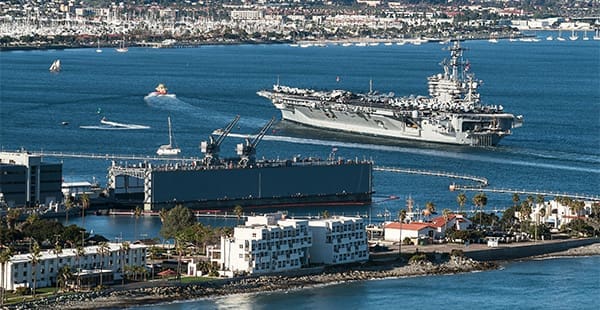How Was Asbestos Used at Naval Bases?
Like other military branches, the U.S. Navy used asbestos for many years. But their asbestos use accelerated during World War II. At that time, the Navy needed to produce many ships very quickly. Because asbestos was so cheap and widely available, it was popular for production. Beyond ships, the Navy also built buildings that contained asbestos.
Places on naval bases where asbestos may have been present include:
- Barracks
- Boiler rooms
- Engine rooms
- Equipment and supply shops
- Houses and apartments
- Repair facilities
The Navy used asbestos construction products. Asbestos was used in insulation products for fireproofing and thermal insulation. The Navy also used woven asbestos textile products, which provided insulation, too. They guarded against electricity, heat and acid.
The Navy was aware of the dangers of asbestos during this time. Congress began passing asbestos safety standards in 1970. But the Navy continued to mandate its use well into the decade.
Most asbestos uses are no longer permitted, but legacy asbestos continues to pose a threat. In 1975, the Navy began replacing damaged asbestos insulation. But they only focused on high-maintenance areas. This means Navy ships and buildings may still contain asbestos today. Those who come into contact with the mineral can develop health issues from exposure.
Resources for Mesothelioma Patients
Notable Naval Bases That Used Asbestos
The U.S. Navy not only used asbestos in their ships for years, they mandated it. They chiefly used it for insulation with fireproofing properties. The military at large had long been using asbestos in on-base housing and other buildings, too.
Some Navy bases with known asbestos use include Charleston Naval Base, Naval Base San Diego and Naval Submarine Base New London.
Charleston Naval Base
Charleston Naval Base in Charleston, South Carolina, was a major hub for the U.S. Navy. It operated from 1901 to 1996. During its tenure, the base employed thousands and built 256 vessels. At its employment height in 1983, over 36,000 service members and civilians worked there.
Asbestos was common throughout ships during the time Charleston Naval Base was in operation. Those who built and repaired ships at Charleston Naval Base often faced exposure. But asbestos was used in buildings, too.
In 2012, the Department of Health and Environmental Control halted demolition at the defunct base. This came after finding asbestos insulation around steam pipes.
Naval Base San Diego
Naval Base San Diego was established in 1922 in San Diego, California. It continues to operate today. During wartime, it provided supplies throughout the Pacific. During World War II alone, more than 5,100 ships were serviced there. Asbestos materials on ships at the base posed an exposure risk to many veterans and civilians.
The base changed its operational function in 1999, becoming the headquarters for many local naval operations. With this change, it was renamed the Commander Navy Region Southwest.
Naval Submarine Base New London
Ground broke on the Naval Submarine Base New London in Groton, Connecticut, in 1868. From modest beginnings, it grew to become the first submarine base during World War I.
The base continued expanding in the 20th century. It more than quadrupled in size during World War II, and the submarine fleet grew along with it. As with other naval ships, the U.S. Navy stipulated that when gaskets, insulation and other products were used in submarines, they should contain asbestos. Many of the base’s buildings and submarines were built when asbestos use was the default. This exposed thousands to the dangerous mineral.
Naval Submarine Base New London still employs over 9,500 people today. Groton, Connecticut, houses 23 submarines, including the first nuclear-powered one.
Other Naval Bases That Caused Exposure
The U.S. Navy mandated asbestos use for many years, so exposure is possible at any base. Below are all remaining active Navy bases where asbestos exposure may occur because of past uses. A mesothelioma lawyer can help you identify other asbestos jobsites not on this list.
California
- China Lake Naval Air Weapons Station
- Naval Air Station Lemoore
- Naval Air Station North Island
- Naval Amphibious Base Coronado
- Naval Base Coronado
- Naval Base Point Loma
- Naval Base San Diego
- Naval Base Ventura County
- Naval Postgraduate School
- San Diego Military Bases
Connecticut
- Naval Submarine Base New London
District of Columbia
- Joint Base Anacostia-Bolling
- Naval District Washington
Florida
- Naval Air Station Jacksonville
- Naval Air Station Key West
- Naval Air Station Pensacola
- Naval Air Station Whiting Field
- Naval Station Mayport
- Naval Support Activity Panama City
- Pensacola Florida Military Bases
- United States Southern Command
Georgia
- Naval Submarine Base Kings Bay
Hawaii
- Joint Base Pearl Harbor – Hickam
- Naval Station Pearl Harbor
- Oahu Hawaii Military Bases
Illinois
- Naval Station Great Lakes
Louisiana
- Naval Air Station Joint Reserve Base New Orleans
Maryland
- Joint Base Andrews
- National Naval Medical Center
- Naval Air Station Patuxent River
- Navy Fort Meade
- NSA Bethesda Walter Reed Medical Center
- U.S. Naval Academy
Mississippi
- Naval Air Station Meridian
- Naval Construction Battalion Center Gulfport
Nevada
- Naval Air Station Fallon
New York
- Naval Support Activity Saratoga Springs
Rhode Island
- Naval Station Newport
South Carolina
- Beaufort South Carolina Military Bases
- Charleston Naval Base
- Joint Base Charleston
- Naval Hospital Beaufort
- Naval Weapons Station Charleston
Tennessee
- Naval Support Activity Mid-South
Texas
- Naval Air Station Corpus Christi
- Naval Air Station Joint Reserve Base Fort Worth
Virginia
- Hampton Roads Military Bases
- Joint Expeditionary Base Little Creek – Fort Story
- Naval Air Station Oceana
- Naval Air Station Oceana Dam Neck Annex
- Naval Amphibious Base Little Creek
- Naval Station Norfolk
Washington
- Naval Air Station Whidbey Island
- Naval Base Kitsap
- Naval Base Kitsap – Bangor
- Naval Base Kitsap – Bremerton
- Naval Hospital Bremerton
- Naval Station Everett
Who Is at Risk of Exposure at Naval Bases?
Anyone who worked at naval bases faced risks of occupational asbestos exposure. Those who performed repairs or worked in enclosed or poorly ventilated areas faced risks of higher exposure levels.
Workers’ families may also be at risk. Families who lived on base may have come into contact with asbestos through construction products in their homes. Workers may also have inadvertently brought asbestos fibers home on their clothing. This can cause secondary exposure. Asbestos exposure can lead to mesothelioma and other cancers.
Asbestos Lawsuits and Compensation
Several compensation options exist for those suffering from an asbestos disease. Service members and veterans may qualify for U.S. Department of Veterans Affairs (VA) benefits. Lawsuits against asbestos companies and asbestos trust fund claims are other possibilities.
Many who worked on naval bases and were diagnosed with asbestos-related diseases have won compensation from companies that supplied asbestos to the Navy.
- A Navy worker who served at Newport Naval Base in Rhode Island won almost $3.5 million.
- A plantworker at Great Lakes Naval Base outside Chicago, Illinois, was awarded over $3 million.
- A maintenance worker at San Diego Naval Base won over $1.1 million.
Speak with an experienced mesothelioma lawyer to determine your options.









